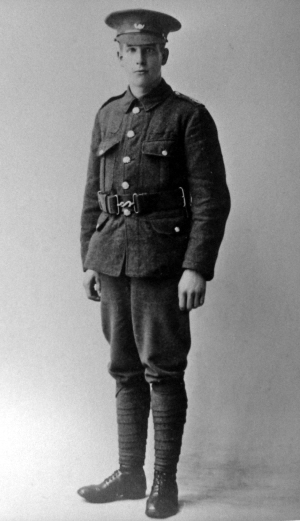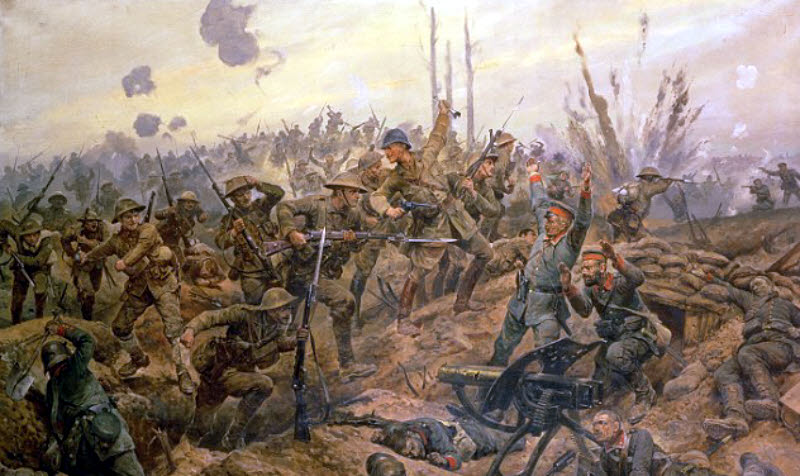
George Arthur Ely was born in 1897 in Ossett, the son of rag merchant Walter Ely and his wife, Sarah Jane (nee Radley), who were married in 1891. In 1901, the Ely family lived in Greatfield Road, Ossett.
By 1911, the Ely family have moved to 15, Little Field, Ossett, now with six children: Harold (18), Edith (16), George Arthur (14), Willie (11), May (9) and Florrie (5). The two eldest children are working in the rag trade, probably for their father, but George was working as an athletic goods maker.
George Ely enlisted with the King’s Own Yorkshire Light Infantry, 9th Battalion, but did not embark for France before the 31st December 1915. He was posthumously awarded the British and Victory medals.
Private Ely was killed in action on the 16th September 1916, aged 19 years during the Battle of Flers-Courcelette, one of the battles of the Somme. Sadly his body was never recovered.
The 9th Battalion, Kings Own Yorkshire Light Infantry was raised at Pontefract in September 1914 as part of Kitchener’s Third New Army and joined 64th Brigade, 21st Division. After initial training close to home they moved to Berkhamsted and then to Halton Park in October. They spent the winter in billets in Maidenhead from November and returned to Halton Park in April 1915. They moved to Witley for final training in August and proceeded to France in September 1915 whereupon their Commanding Officer, Lieutenant-Colonel C.W.D. Lynch had made himself extremely unpopular by ordering the whole of the Battalion to shave their heads, following a report that there had been a number of head wounds which had become fatal, due to infection in the victims hair.1 They marched across France and went straight into action in reserve of the British assault at Loos on the 26th of September, suffering heavy casualties.
In 1916 they were in action in the Battles of The Somme, including The Battle of Morval in which the Division captured Geudecourt. In 1917, they were in action during The German retreat to the Hindenburg Line, the Arras offensive, the Third Battles of Ypres and The Cambrai Operations. In 1918 they fought on The Somme then moved north and were in action during the Battles of the Lys,,the Battle of the Aisne, The Somme, the Battles of the Hindenburg Line and the Final Advance in Picardy. At the Armistice the Division were around Berlaimont, on the 12th they moved to Beaufort, then in mid December they moved west of Amiens and demobilisation began being completed by the 19th of May 1919.
During the Battle of Flers-Courcelette, on the 16th September 1916, with the village of Flers in British hands, the next objective had been the capture of the neighbouring village of Gueudecourt, to the north-east. However, before the village could be taken, two heavily defended positions, Gird Trench, and Gird Support first had to be seized. Originally an objective of the sorely depleted 41st Division, the job had eventually been given to the 64th Brigade (9th and 10th Battalions of the Kings Own Yorkshire Light Infantry, 1st East Yorkshire Regiment, and 15th Durham Light Infantry) of the 21st Division, who were to be attached to the former unit for the operation.
The men who were to undertake the attack on the two positions had begun to move up to their assembly point in pouring rain in the early hours of the 16th September 1916, reaching Flers Trench just as it was getting light, a little before 6am. Apparently an ill-prepared affair, the officers who were to lead the attack, planned to begin at 9:20 a.m., had not been able to make a preliminary reconnaissance of the terrain they were being told to cross, nor of the objectives themselves. Another problem was that in order to take advantage of the timed artillery barrage that was to support the advance it would be necessary to get the men forward to a position near enough to the barrage to get cover from it as they made their advance across No Mans Land’. To achieve this the infantry would have to advance twenty or so minutes before “Zero Hour”, across open country, in broad daylight and under fire to be up behind the barrage when it started. In short, to commit suicide.
The rain that had drenched the soldiers during the night had by “Zero Hour” disappeared, to make way to a fine and sunny day. At the allotted time, sixty fourth Brigade, with 9th KOYLI and 15th DLI in front, and the two other Battalions in support had begun to make their 1,500 yards advance towards their first objective, Gird Trench. The History of the Battalion, records what had happened next:
“This was done under fire, and the 9/KOYLI, advanced well and in fair formation to approximately fifty yards from the objective, where it occupied the shell craters that were everywhere existing. The losses had been very heavy [from machine gun fire and shrapnel] and the attack that followed was not made in sufficient strength to prevail. The position in the craters was held throughout the day, but under the cover of darkness the troops were withdrawn to the road running from Flers village towards Lesboeufs”.2
The casualties incurred during this appalling waste of life, were four officers killed, six wounded, and three missing. The “Other Ranks” had forty-three killed, a hundred and eighty wounded, and a further hundred and fifty three were missing. As part of 9th Battalion, KOYLI, Private George Arthur Ely never stood a chance in the carnage that occurred on that day and would be one of the 153 men that were posted missing for his body was never found.

George Arthur Ely, aged 19 years, died on the 16th September 1916. He is remembered Pier and Face 11C and 12A on the Thiepval Memorial,3 Somme, France. The Thiepval Memorial can be found on the D73, next to the village of Thiepval, off the main Bapaume to Albert road (D929).
On 1 July 1916, supported by a French attack to the south, thirteen divisions of Commonwealth forces launched an offensive on a line from north of Gommecourt to Maricourt. Despite a preliminary bombardment lasting seven days, the German defences were barely touched and the attack met unexpectedly fierce resistance. Losses were catastrophic and with only minimal advances on the southern flank, the initial attack was a failure. In the following weeks, huge resources of manpower and equipment were deployed in an attempt to exploit the modest successes of the first day. However, the German Army resisted tenaciously and repeated attacks and counter attacks meant a major battle for every village, copse and farmhouse gained. At the end of September, Thiepval was finally captured. The village had been an original objective of 1 July. Attacks north and east continued throughout October and into November in increasingly difficult weather conditions. The Battle of the Somme finally ended on 18 November with the onset of winter.
In the spring of 1917, the German forces fell back to their newly prepared defences, the Hindenburg Line, and there were no further significant engagements in the Somme sector until the Germans mounted their major offensive in March 1918.
The Thiepval Memorial, the Memorial to the Missing of the Somme, bears the names of more than 72,000 officers and men of the United Kingdom and South African forces who died in the Somme sector before 20 March 1918 and have no known grave. Over 90% of those commemorated died between July and November 1916. The memorial also serves as an Anglo-French Battle Memorial in recognition of the joint nature of the 1916 offensive and a small cemetery containing equal numbers of Commonwealth and French graves lies at the foot of the memorial.
The memorial, designed by Sir Edwin Lutyens, was built between 1928 and 1932 and unveiled by the Prince of Wales, in the presence of the President of France, on 1 August 1932 (originally scheduled for 16 May but due to the death of French President Doumer the ceremony was postponed until August).
The dead of other Commonwealth countries, who died on the Somme and have no known graves, are commemorated on national memorials elsewhere.
References:
1. “The Bloody Battle of the Somme 1916” (from the book “Neath a Foreign Sky” by Paul Allen)
2. “The History of the K.O.Y.L.I. during the Great War 1914—1918” by Wylly & Bond.